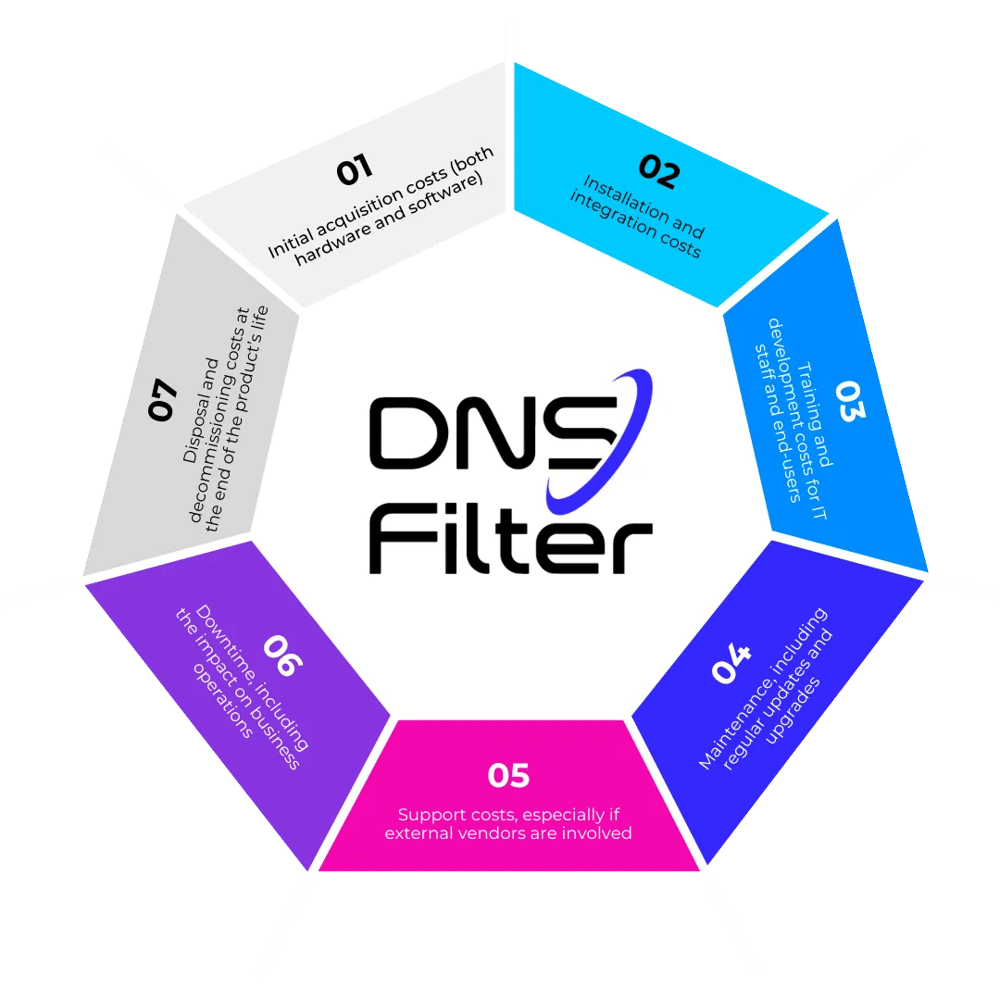DNS Price: Total Cost of Ownership Analysis
by Kory Underdown on May 22, 2024 1:08:48 PM
Mastering IT Budgets: How to Conduct a Thorough Total Cost of Ownership (TCO) Analysis of Your IT Infrastructure
In today's rapidly evolving technological landscape, enterprises are continually seeking ways to optimize their IT investments to enhance efficiency and reduce costs. One crucial metric that aids in this endeavor is the Total Cost of Ownership (TCO). Understanding TCO is vital for companies, especially when evaluating DNS solutions and other IT infrastructure, where costs can escalate quickly if not properly managed.
TCO goes beyond the initial purchase price, encompassing all costs associated with the acquisition, deployment, use, and maintenance of IT products. It provides a comprehensive view of financial implications, helping businesses make more informed decisions that affect their long-term financial health.
This article is particularly relevant for enterprise companies looking to streamline their IT costs. Many companies are transitioning away from single-solution software like the retired Cisco Umbrella Roaming Client and are in need of more versatile and economically favorable options. By understanding and applying a thorough Total Cost of Ownership analysis, companies can evaluate potential IT tools not only based on their sticker price or DNS price but on a broader scale of long-term financial impacts, including maintenance, support, scalability, and the often-overlooked indirect costs.
This article will cover the essential aspects of TCO in IT investments—starting with what TCO entails, the primary cost components to consider, and moving towards how to perform a detailed TCO analysis, calculate it effectively, and leverage this understanding to achieve significant TCO savings. Let’s jump in!
Understanding Total Cost of Ownership (TCO)
Total Cost of Ownership (TCO) is a financial estimate designed to help consumers and enterprise managers determine the direct and indirect costs related to the purchase of any IT infrastructure, including DNS systems. TCO encapsulates the overall long-term costs of products or systems, not just the initial expenditure. Understanding TCO is crucial for businesses as it impacts budgeting, strategy, and operational decisions, ensuring that every technology investment is justified not only in terms of cost but also the value it delivers over its lifespan.
Components of TCO
When it comes to IT investments, the Total Cost of Ownership can be broken down into three primary cost components:
Direct Costs: These are the upfront expenses associated with purchasing software or hardware. In the context of DNS solutions, this might include the DNS price for software licenses or hardware devices needed to implement the solution.
Indirect Costs: These costs are not always visible on the balance sheet but can significantly impact the total investment. They include costs like employee training, downtime during implementation and upgrades, and even the opportunity cost of choosing one solution over another.
Opportunity Costs: These represent potential benefits lost when one choice is selected over another. For example, if a less expensive, less reliable DNS solution is chosen, the opportunity cost might be the additional revenue that could have been generated with a more robust system that offers higher uptime and better performance.
Understanding these components helps businesses in not only identifying where their money is going but also in strategizing how to manage these costs effectively. A comprehensive TCO analysis should consider the following five critical elements to provide a clear financial picture of IT investments:
| Capital Costs | Operational Costs | Utility Costs | Training Costs | Downtime Costs |
| The purchase price of the hardware or software. | Ongoing expenses such as maintenance, upgrades, and support. | Costs related to the energy consumption and cooling of IT systems. | Expenses associated with training employees to use new systems effectively. | Lost productivity costs during system outages or malfunctions. |
Include all product lifecycle costs in your TCO analysis

By carefully including these criteria, your business can achieve a holistic view of what an IT investment will truly cost over its useful life, ensuring no hidden costs surprise them down the line. This comprehensive approach to TCO not only helps in budgeting and forecasting but also in comparing the long-term value of various solutions.
How to Perform a Total Cost of Ownership (TCO) Analysis
Conducting a TCO analysis is essential for organizations to grasp the long-term cost implications of IT investments, such as DNS solutions. Here’s a step-by-step guide to performing an effective TCO analysis:
|
Identify Costs: |
Gather Data: |
Forecast Costs: |
Calculate TCO: |
Analyze Results: |
|
Start by listing all potential costs associated with the product or service over its expected life. This includes both direct and indirect costs, as well as any opportunity costs. |
Collect data on each cost component. This might involve historical data from similar projects, quotes from vendors, and estimates from project managers or IT staff. |
Use the gathered data to forecast future costs. Consider changes in technology, potential vendor price increases, and expected changes in operational needs. |
Sum all the identified and forecasted costs to calculate the total cost of ownership. Various tools and software can assist in this calculation, ensuring accuracy and comprehensiveness. |
Analyze the calculated TCO to determine if the investment is justified. Compare it against alternative solutions and assess whether the benefits outweigh the costs. |
Popular Methodologies to Calculate the TCO of a DNS System
Here are two common methodologies that incorporate both direct and indirect costs, ensuring a comprehensive financial analysis your CFO will respect:
Simple Summation Method: This approach involves adding up all costs—both initial and ongoing—associated with the IT asset. This method is straightforward but may oversimplify some aspects by not accounting for the time value of money.
Net Present Value (NPV) Method: This more sophisticated method discounts future costs and benefits to their present values. Using a discount rate, typically the organization's cost of capital, this method helps in comparing costs that occur at different times, providing a more accurate financial picture.
Key Elements of TCO for a DNS System
When analyzing the Total Cost of Ownership (TCO) for a DNS system, it's essential to consider both immediate and long-term costs associated with its procurement, deployment, and maintenance. Here are the key elements to consider:
| TCO = | Capital Expenses (CapEx) + | Operational Expenses (OpEx) + | Change Costs + | Risk Costs - | Residual Value |
- Capital Expenses (CapEx): These are the upfront costs involved in purchasing DNS hardware and software. This includes the cost of servers, network infrastructure, and initial software licenses required to set up and run the DNS services.
- Operational Expenses (OpEx): These ongoing expenses cover the daily operations of the DNS system. It includes energy costs, network bandwidth expenses, and costs related to ongoing management and staffing required to maintain DNS uptime and responsiveness.
- Change Management Costs: DNS systems may require changes due to business growth, technology upgrades, or regulatory requirements. These costs include the resources needed for implementing updates, migrating to new platforms, and training staff on new functionalities.
- Risk Costs: Given the critical nature of DNS services, the potential costs from risks such as system failures, cyber-attacks, or data breaches can be significant. This includes investment in security measures, insurance, and contingency planning.
- Residual Value: At the end of its useful life, a DNS system may have a residual value depending on the hardware and software components that can be repurposed or sold.
LEARN MORE:
Cisco Umbrella RC End-of-Life: What You Need to Know to Migrate Your DNS
Inclusion Criteria for a TCO Analysis of a DNS System
This detailed breakdown not only helps in budgeting and forecasting but also provides insights into potential areas for cost savings in managing a DNS system:
- Installation and Configuration Costs: Includes expenditures for setting up DNS servers and configuring them to fit into the existing IT infrastructure. This may also involve costs for initial security setup and integration with other network components.
- Software Licenses: Beyond initial purchases, DNS systems might require periodic license renewals or purchases of additional licenses as the network scales or as additional features are needed.
- Maintenance and Upgrades: Regular maintenance ensures the DNS system runs efficiently and is up-to-date with the latest security patches and performance upgrades. This includes costs for replacement parts, technician labor, and software updates.
- Training and Development: As DNS technologies evolve, continuous training and development for IT staff are crucial. Costs here include training sessions, certifications, and possibly hiring of specialists to handle advanced DNS management or security features.
- Operational Downtime: The costs associated with potential downtimes, which can include lost business opportunities, customer dissatisfaction, and emergency response efforts. Planning for high availability and redundancy can mitigate these costs but also involves additional investment.
- End-of-Life Disposal: When DNS hardware reaches the end of its useful life, disposing of it responsibly can incur costs related to data wiping, recycling, or physically destroying hard drives to ensure data confidentiality.
LEARN MORE:
The Right Way to Compare DNS Filtering Systems
Example of a TCO Calculation for a DNS System
Let's calculate the TCO for a hypothetical DNS solution over a five-year period. We’ll use the NPV method and assume a discount rate of 5%:
- Year 0 Costs: Hardware purchase ($10,000), Software license ($5,000), Installation ($3,000).
- Annual Costs: Maintenance ($2,000 per year), Software updates ($1,000 per year).
- Year 5 Costs: Decommissioning ($2,000).
| Year-by-Year Cost Breakdown: | ||
| Year 0 Costs: | Years 1 to 4 Costs: | Year 5 Costs: |
|
Purchase: $10,000 Software license: $5,000 Installation: $3,000 Total Year 0 Costs: $18,000 |
Maintenance: $2,000/yr Software updates: $1,000/yr Year 1-4 Costs: $3,000 /yr |
Decommissioning: $2,000 Maintenance: $2,000 Software updates: $1,000 Year 5 Costs: $5,000 |
| Net Present Value (NPV) Calculations | ||
|
𝑃𝑉𝑌𝑒𝑎𝑟0=$18,000 |
𝑃𝑉𝑌𝑒𝑎𝑟1=$3,000(1+0.05) 𝑃𝑉𝑌𝑒𝑎𝑟2=$3,000(1+0.05) 𝑃𝑉𝑌𝑒𝑎𝑟3=$3,000(1+0.05) 𝑃𝑉𝑌𝑒𝑎𝑟4=$3,000(1+0.05) |
𝑃𝑉𝑌𝑒𝑎𝑟5=$5,000(1+0.05) |
| Total Cost of Ownership | ||
| TCO = $18,000 + $2,857 + $2,721 + $2,591 + $2,468 + $3,917 = $32,554 | ||
This example provides a clear breakdown of how each component contributes to the overall TCO and helps stakeholders understand the long-term financial commitments of their DNS investments.
Strategies to Lower Total Cost of Ownership
Reducing the Total Cost of Ownership (TCO) is crucial for organizations aiming to optimize their IT expenditures and enhance overall operational efficiency. Here are some effective strategies specifically tailored to manage costs associated with DNS solutions and broader IT infrastructure:
Adoption of Scalable Technologies: Investing in scalable solutions that can grow with the company's needs can prevent the frequent and costly upgrades associated with less flexible systems. Cloud-based DNS solutions are an example, as they allow businesses to scale up or down based on demand without significant upfront investments.
Automated Management Tools: Utilizing automation for the management of DNS and other IT systems can significantly reduce labor costs and minimize human error, leading to fewer costly incidents and more stable operations.
Regular Audits: Conducting regular audits of IT and DNS usage can help identify underutilized resources or inefficiencies that are adding unnecessary costs, allowing for timely adjustments.
Long-term Contracts: Negotiating longer-term contracts with vendors can lock in lower rates and often secure additional support services at a reduced cost, helping to lower overall TCO.
Understanding TCO Savings
TCO savings refer to the reduction in total cost ownership over the life of an IT investment. Understanding and maximizing TCO savings is vital for demonstrating the value of investments and improving the return on investment (ROI). Here’s how TCO savings can significantly impact an organization:
- Direct Cost Reduction: Lowering immediate expenses such as hardware costs, licensing fees, or operational expenditures directly decreases TCO.
- Indirect Benefits: Enhancements in system efficiency and reliability can reduce downtime and maintenance needs, indirectly cutting costs and boosting productivity.
- Strategic Advantages: Lower TCO allows a company to reinvest the savings into other strategic areas, such as R&D or market expansion, fostering better competitive positioning and business growth.
The concept of Total Cost of Ownership (TCO) plays a crucial role in the strategic planning and management of DNS solutions within IT infrastructures. By comprehensively assessing TCO, organizations can fully understand the long-term financial and operational implications of their DNS investments. This analysis goes beyond mere acquisition costs to include maintenance, updates, risk management, and eventual decommissioning, ensuring that every aspect of expenditure is accounted for. Understanding the TCO helps businesses avoid underestimating the resources needed for continuous operation and maintenance, which can lead to significant unplanned expenses.
Moreover, a detailed TCO analysis for DNS systems doesn't just tally costs; it uncovers opportunities for significant savings and efficiencies. It provides insights into how different choices—such as the selection between on-premise versus cloud-based solutions—impact expenses in the long run. This understanding allows companies to make strategic decisions that optimize performance and cost, such as investing in more scalable and secure DNS technologies that offer better long-term value.
By prioritizing a comprehensive evaluation of TCO, organizations can ensure that their DNS investments are not only justified financially but also align with broader business objectives.
Don't let hidden costs undermine your IT initiatives—take control of your technology investments by making TCO analysis a cornerstone of your decision-making process. Let’s Talk!
 Inside Business Email Compromise Scams: How to Protect Your Business
Inside Business Email Compromise Scams: How to Protect Your Business
The Scam That Outsmarts Awareness Training
It starts with a routine email.
 How to choose the right DNS provider for the job
How to choose the right DNS provider for the job
Choosing a DNS provider used to be about speed. Today, it’s about security. The Domain Name System (DNS) has evolved from a simple directory of the internet into a critical control point for visibility, compliance, and protection. The right provider can identify and block malicious activity before it ever reaches your endpoints, keeping your users safe—no matter where they connect. That’s why DNS filtering has become one of the most effective, ...



